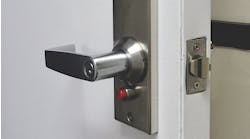We have seen enough of acts of public violence. On the heels of Sandy Hook comes the Boston Marathon. Sharing lessons learned, best practices and cost-effective solutions can help prevent future incidents. Not every incident can be averted, but planning, training and testing can result in a timely response to a potential threat. Many schools were designed 30 or more years ago and need upgrades to address today’s security needs.
“Target-hardening” a facility prevents an aggressor from reaching his or her destination. Introducing protection “layers” or “zones” may help stop or slow an aggressor and provide an occupant with time to manage an emergency. Effective planning of the site perimeter zone, the building perimeter zone and the building interior zone enables designers to make a difference and save lives.
The site perimeter zone begins at a site entrance with features designed to verify and slow down an aggressor. Defining a clear line of sight denies a visitor a pathway choice and alerts personnel if someone is deviating from the defined route. Establishing vehicular circulation routes from the site entrance to parking areas—including curved pathways (to prevent acceleration), high curbs, speed bumps and concise directional signage—helps control access. Signage should direct vehicles to exclusive and non-exclusive areas. Exclusive areas (e.g., visitor parking, space between sidewalk and entry) help alert staff members when a visitor is approaching the building for non-routine purposes. This area can be bolstered with security devices and personnel. Non-exclusive areas (student and staff parking) are situated farther from the building. For both areas, institutions should provide lighting and cameras for ease of detection. Situating most parking away from the building provides for a more controlled environment.
The building perimeter zone includes the exclusive area of the site and area immediately outside the building. This zone is established to stop or slow down and expose an aggressor, and alert people inside the school. The building entrance defines the main pathway; site elements such as berms, low areas, trees, shrubs, bollards and boulders protect the building perimeter and stop or slow down a vehicle from accelerating into the building. Thick groundcover and tall grasses should be avoided so that they don’t obscure a person or device. A school should be able to monitor the building perimeter zone from its central control room. Situate main utilities (e.g., water supply, generators, fuel storage, phone switchgear) away from the main entrance so that an intruder can’t target them.
The building interior zone begins at the building wall and entrance. Protecting occupants from an aggressor is the main objective. The main entrance typically is the most vulnerable penetration point. If an aggressor has passed undetected through the site perimeter zone and the building perimeter zone, a “target-hardened” line is essential at the main entrance.
Many buildings have electronically controlled doors with office visibility through laminated glass. Panic buttons at the reception desk and backup locations enable staff members to respond to a threat immediately. Panic buttons lock all doors, contact local emergency agencies, close and lock doors to compartmentalize building zones, and move occupants to safe areas.
Keeping a visitor outdoors is not practical, so buildings typically have a “holding area” or vestibule. This allows time for visitor verification. Unfortunately, vestibule doors provide minimal “target-hardening” for the school interior; a stronger line of defense must occur at this location. Perhaps two vestibules are needed (one for verification and clearance check, and one for access only to the main office). Schools should have laminated glass at doors and windows at this location, and electronic locks to “hold” an aggressor so emergency systems can engage and occupants can protect themselves. Zoning inside the building seals off sections of the building, preventing access during a lock-down emergency.


